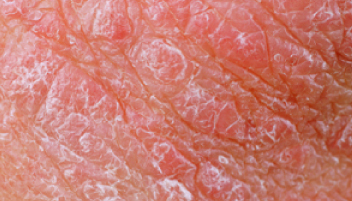
Skin Irritations
Allergic Reactions & Skin Allergy Symptoms, Diagnosis and Treatment
Your doctor calls it “contact dermatitis.” It’s a red, sometimes blistering, cracking or scaly rash, with a red-hot itch that can drive you crazy. And once you’ve experienced it, you may develop a sensitivity that can cause the symptoms to recur and become increasingly more severe after just the briefest contact with whatever caused the initial irritation.
Skin is your body’s defense against the elements of the outside world, but what happens when your skin becomes too irritated and sensitive to protect you? And what makes your skin suddenly react so badly?
Approximately 80% of all cases of contact dermatitis are caused by contact with something that irritates your skin, such as detergents, soaps,or cleaning supplies.About 20% of the time, it’s an allergic reaction to something such as jewelry, or a scent that was added to a product. The causes are a bit confusing, and sometimes even healthcare professionals have a hard time determining whether an allergy or an irritant caused a particular rash. Although the causes differ, the skin symptoms, skin allergies treatment, and prevention of these conditions are very similar.
Symptoms
Regardless of what type of skin allergy you have, there are a few commonalities among the symptoms you’ll likely see on your skin. It’s important to understand what triggers the irritations on your skin and avoid those factors as much as possible.
These are some of the symptoms that are commonly associated with dermatitis:
- Redness and swelling
- Severe itching
- Bumps or blisters that may ooze fluid
- Peeling, cracking or flaking of the skin
- Rash
Call your healthcare provider if:
- The rash is near your eyes
- The rash covers a large part of your body
- You can’t control the itching with non-prescription products
- The rash shows signs of being infected (pus, odor, increasing swelling, pronounced redness, red radiating streaks, or skin that is hot to the touch).
- If condition worsens or symptoms persist for more than 7 days
Is it contagious? No. These sorts of skin irritations are caused by direct contact with an irritant, or an allergic reaction to a particular substance.
But if you experience an unexplained, severe, or prolonged skin irritation that won’t go away with over-the-counter treatment and a little time, then consider seeking medical treatment from a trusted doctor. If symptoms of your allergic reaction do not improve over a few days or worsen, don’t try to deal with it yourself. Children often develop rashes, so it’s importance to check your kids’ skin regularly for possible reactions and irritations.
If you develop a skin rash with blisters, it may be a sign of a more serious condition that requires immediate attention. Other serious symptoms to keep an eye out for include trouble breathing, swelling of the throat, wheezing, chest tightness, excessive sweating, nausea, or lightheadedness. Most rashes are merely nuisances and go away on their own; however, other rashes can actually be life-threatening.
Causes
Skin rashes can be caused by a wide variety of factors that are environmental, hereditary, and even linked to immune system disorders. They can also be caused by infections that your body is fighting and medications you are taking for completely unrelated health conditions. Food allergies can cause skin rashes, as well as illnesses like chicken pox and the measles. However, other materials, such as laundry detergents, fabric softeners, soaps, shampoos, and nickel can cause contact dermatitis as well.
Skin allergies occur when your immune system reacts to foreign substances that touch your skin. There are many substances that we encounter in our daily lives that serve as triggers for skin allergies. Your current health and state-of-mind may make you more susceptible to falling prey to those triggers at some times more than others.
Common triggers are perfumes, cosmetics, laundry detergents, shampoos, and other health and beauty products that have fragrances. Even some products that say “unscented” on the label can contain allergens that affect your skin. Skin allergies can also be caused by latex, which is used in rubber gloves, condoms, waistbands, rubber bands, and other household products. Hair dye, clothing dye, poisonous plants, sunscreen, household solvents, and adhesives can also cause your skin to react and become symptomatic.
Nickel allergies are common among people who wear jewelry, especially inexpensive jewelry made with cheap metals. A nickel allergy is categorized under the skin reaction of “contact dermatitis,” which means that a skin reaction occurs after coming in direct contact with an irritant. Nickel is a component of stainless steel and other metals used to make jewelry. Nickel allergies can appear on any part of the body that you wear jewelry on, including the neck, ears, fingers, wrists, ankles, and belly button area.
The most common irritants and allergens include:
- Jewelry (especially jewelry that contains nickel, which is found in many products including buttons, eyeglass frames, zippers, kitchen utensils, some coins, green felt dye (think pool tables), alkaline batteries, some cell phones, and paper clips.)
- Detergents
- Soaps and cleaning products
- Fragrances added to cosmetics, fabric softeners, deodorants, body lotions, tissues and toilet paper
- Hair coloring
- Latex, which may be used in things such as balloons, Band-Aids, condoms, plastic gloves, waistbands and other articles of clothing, bras, and toys.
- Medicinal lotions, especially antibiotic creams with neomycin
- Dye used in clothing, fur and leather products
- Poison ivy, poison oak/sumac and other plants.
- Nickel, a metal widely used in jewelry, is one of the most common skin irritants. If you suddenly develop a reaction to a piece of jewelry that you’ve worn with no problem for a long time, it’s likely that nickel is now leaching through the top layer of metal and coming in contact with your skin. Try coating the jewelry – just the parts that contact your skin – with clear nail polish to create a new barrier.
- Some products cause rashes only when skin is exposed to sunlight. These include sunscreens, topical antibiotics, some perfumes, tattoo pigment (especially red ink), and oil from the skin of a lime.
- The percentage of the U.S. population that tests positive to one or more allergens: 55%
- An overwhelming fear of allergies or allergic reactions is called Hesteminophobia.
Skin Allergy Treatment
There are many factors to consider when choosing a skin allergic reaction treatment, including the severity of the symptoms, the frequency of the rash, and the location of the rash on your skin. If you notice an allergic reaction on skin, don’t panic. Retrace your steps of the circumstances that led up to developing the rash to try to determine the cause.
As noted above, skin responses to irritants and allergens typically worsen with repeated contact. Unfortunately, it isn’t always easy or practical to avoid all contact with the substances that may irritate your skin. Domeboro® provides fast relief, relieves the irritation, helps to dry the rash and reduce its redness, and supports the healing process. Doctor-recommended for the treatment of skin irritations for over five decades, you can depend on Domeboro® to reduce the uncomfortable symptoms caused by an irritant or allergen.
One particularly effective product for skin allergies treatment is the Domeboro® Soothing Soak, which contains the active ingredients of aluminum sulfate tetradecahydrate and calcium acetate monohydrate. This is especially useful for the temporary relief of skin irritations caused by poison ivy, poison oak, poison sumac, insect bites, jewelry rashes, cosmetics rashes, and soap/detergent rashes.
There are a few different ways that you can use Domeboro® products to soothe the symptoms of your skin rash and get back to living your life. Domeboro® can be used with a compress/wet dressing or as a soak. Mix one, two, or three packets in 16 ounces of cool or warm water.
Compress or wet dressing: Immerse a compress or wet dressing in the solution and apply to affected area for 15 to 30 minutes. Repeat as needed or as directed by a doctor.
Soak: Immerse the affected area directly in the solution for 15-30 minutes. Repeat the soak three times a day or as directed by a doctor. Discard the solution after each use.
Other Skin Allergic Reaction Treatments
At the first sign of skin irritation, wash the affected area with a fragrance-free soap and cool water as soon as possible to remove the irritant or allergen. Use rubbing/isopropyl alcohol or dish detergent if the irritant has an oil base.
You may also want to try applying over-the-counter medications such as calamine lotion or cortisone cream. Severe itching may require prescription strength cortisone cream.
Allergy shots are not useful in treating most skin conditions; however, topical medications are often recommended by doctors to relieve the symptoms, restore moisture, and deliver medication to rashes. Meanwhile, natural home remedies for skin rashes often include ingredients like tea tree oil, coconut oil, apple cider vinegar, aloe vera, olive oil, baking soda, and oatmeal.
Prevention
Skin allergies are very common among children, teens, adults, and the elderly, and they affect people of all different skin types and backgrounds. If you develop an allergic reaction rash, it’s important to identify the cause of the rash and pay close attention to your symptoms. Although skin rashes are very common and often more of an unsightly nuisance than anything else, they could also be a sign of a more serious condition or lead to complications if left untreated. Ultimately, the type of rash you have will determine the best way to treat it and restore the natural health and beauty of your skin.
Try to determine what caused the problem. If it’s an allergic reaction, the rash will typically be in a small area, which was exposed to the allergen (such as a rash that wraps around your wrist after wearing a watch). A rash that is more widespread tends to come from an irritant. The obvious suspect is something new, such as new jewelry, laundry detergent, etc. However, it is also common to develop new allergies over time.
The best way to prevent contact dermatitis is to protect your skin from known irritants and allergens. This may include wearing heavy-duty vinyl gloves with cotton liners when you’re handling products that may cause reactions. It may be possible to protect your skin with a thick coating of oil or other barrier cream, assuming this doesn’t make your hands too slippery. You may want to use only fragrance-free products if your skin is sensitive to a variety of scents. You can try coating items that may contain nickel with clear nail polish to create a barrier between the item and your skin. For pierced ears, look for earrings made of surgical steel, which is the metal least likely to cause a reaction.
Taking good care of your skin every day can go a long way in preventing many skin conditions from ever forming. Make simple lifestyle changes, such as using nourishing moisturizers, keeping your fingernails short to prevent scratching, and using natural skin products that don’t contain harsh chemical ingredients.
For effective skin allergies treatment, learn more about Domeboro®.
